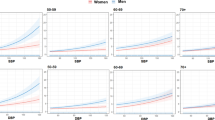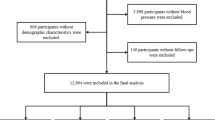Abstract
The study evaluated the extent to which high normal blood pressure (HNBP), elevated BP, and Stage 1 hypertension predict 10-year incidence of cardiovascular disease (CVD). A population-based, prospective cohort study was conducted among 3042 randomly selected Greek adults, aged 18–89 years. Following 10-years follow-up (2002–2012), incidence of non-fatal and fatal CVD (ICD-10) was achieved in 2020 participants. The analytic sample (n = 1403) excluded hypertensive patients. At baseline, the prevalence rate of HNBP, elevated BP, and Stage 1 hypertension was 44.6% (n = 626), 29.0% (n = 408), and 15.5% (n = 218), respectively. During follow-up, the 10-year combined (fatal or non-fatal) CVD incidence rates in HNBP, elevated BP, and Stage 1 hypertensive individuals were 15.6% (n = 98), 12.0% (n = 49), and 22.5% (n = 49), respectively, as compared to 6.3% (n = 49) in normotensives (all p’s < 0.0001). As compared to normotensives (and following the adjustment for known demographic, lifestyle and clinical confounding factors), HNBP participants had a 1.5-fold (Adjusted Hazard Ratio, Adj. HR: 1.49; 95% CI: 1.00–2.20) increased risk of 10-year CVD events. Similarly, Stage 1 hypertensive participants had an approximately twofold (Adj. HR: 1.90; 95% CI: 1.16–3.08) increased risk for 10-year CVD, particularly among males (Adj. HR: 2.03; 95% CI: 1.08–3.83). However, individuals with elevated BP did not exhibit a differential risk for developing 10-year CVD events (Adj. HR: 1.28; 95% CI: 0.82–2.02). Therefore, since HNBP and Stage 1 hypertension individuals exhibit a notable increased risk of 10-year fatal and non-fatal CVD, the implementation of targeted primary and secondary prevention interventions may deter both CVD and related adverse health outcomes.
This is a preview of subscription content, access via your institution
Access options
Subscribe to this journal
Receive 12 digital issues and online access to articles
$119.00 per year
only $9.92 per issue
Buy this article
- Purchase on Springer Link
- Instant access to full article PDF
Prices may be subject to local taxes which are calculated during checkout


Similar content being viewed by others
References
Whelton PK, Carey RM, Aronow WS, Casey DE Jr., Collins KJ, Dennison Himmelfarb C, et al. 2017 ACC/AHA/AAPA/ABC/ACPM/AGS/APhA/ASH/ASPC/NMA/PCNA Guideline for the Prevention, Detection, Evaluation, and Management of High Blood Pressure in Adults: A Report of the American College of Cardiology/American Heart Association Task Force on Clinical Practice Guidelines. J Am Coll Cardiol. 2018;71:e127–248.
Brook RD, Rajagopalan S. 2017 ACC/AHA/AAPA/ABC/ACPM/AGS/APhA/ASH/ASPC/NMA/PCNA Guideline for the Prevention, Detection, Evaluation, and Management of High Blood Pressure in Adults. A report of the American College of Cardiology/American Heart Association Task Force on Clinical Practice Guidelines. J Am Soc Hypertens: JASH. 2018;12:238.
Nadar SK, Stowasser M. New guidelines with few takers: will the new American guidelines ever be accepted? J Hum Hypertens. 2018;32:387–9.
Qureshi AI, Suri MF, Kirmani JF, Divani AA. Prevalence and trends of prehypertension and hypertension in United States: National Health and Nutrition Examination Surveys 1976 to 2000. Med Sci Monit : Int Med J Exp Clin Res. 2005;11:CR403–9.
Qi Y, Han X, Zhao D, Wang W, Wang M, Sun J, et al. Long-Term cardiovascular risk associated with stage 1 hypertension defined by the 2017 ACC/AHA Hypertension Guideline. J Am Coll Cardiol. 2018;72:1201–10.
Son JS, Choi S, Kim K, Kim SM, Choi D, Lee G, et al. Association of Blood Pressure Classification in Korean Young Adults According to the 2017 American College of Cardiology/American Heart Association Guidelines With Subsequent Cardiovascular Disease Events. JAMA. 2018;320:1783–92.
Yano Y, Reis JP, Colangelo LA, Shimbo D, Viera AJ, Allen NB, et al. Association of Blood Pressure Classification in Young Adults Using the 2017 American College of Cardiology/American Heart Association Blood Pressure Guideline with Cardiovascular Events Later in Life. JAMA. 2018;320:1774–82.
Ishikawa Y, Ishikawa J, Ishikawa S, Kario K, Kajii E. Progression from prehypertension to hypertension and risk of cardiovascular disease. J Epidemiol. 2017;27:8–13.
Guo X, Zhang X, Guo L, Li Z, Zheng L, Yu S, et al. Association between pre-hypertension and cardiovascular outcomes: a systematic review and meta-analysis of prospective studies. Curr Hypertens Rep. 2013;15:703–16.
Shen L, Ma H, Xiang MX, Wang JA. Meta-analysis of cohort studies of baseline prehypertension and risk of coronary heart disease. Am J Cardiol. 2013;112:266–71.
Wang S, Wu H, Zhang Q, Xu J, Fan Y. Impact of baseline prehypertension on cardiovascular events and all-cause mortality in the general population: a meta-analysis of prospective cohort studies. Int J Cardiol. 2013;168:4857–60.
Okosun IS, Boltri JM, Anochie LK, Chandra KM. Racial/ethnic differences in prehypertension in American adults: population and relative attributable risks of abdominal obesity. J Hum Hypertens. 2004;18:849–55.
Khosravi A, Gharipour M, Nezafati P, Khosravi Z, Sadeghi M, Khaledifar A, et al. Pre-hypertension, pre-diabetes or both: which is best at predicting cardiovascular events in the long term? J Hum Hypertens. 2017;31:382–7.
Lenfant C, Chobanian AV, Jones DW, Roccella EJ. Seventh report of the Joint National Committee on the Prevention, Detection, Evaluation, and Treatment of High Blood Pressure (JNC 7): resetting the hypertension sails. Hypertension. 2003;41:1178–9.
Tyson CC, Smith PJ, Sherwood A, Mabe S, Hinderliter AL, Blumenthal JA. Association between normal or mildly reduced kidney function, cardiovascular risk and biomarkers for atherosclerosis: results from the ENCORE trial. Clin Kidney J. 2017;10:666–71.
Ferreira AS. Immunity, Inflammation, and Prehypertension: In What Order? J Clin Hypertens (Greenwich). 2015;17:775–6.
Navarro-Gonzalez JF, Mora C, Muros M, Garcia J, Donate J, Cazana V. Relationship between inflammation and microalbuminuria in prehypertension. J Hum Hypertens. 2013;27:119–25.
Caillon A, Schiffrin EL. Role of inflammation and immunity in hypertension: Recent epidemiological, laboratory, and clinical evidence. Curr Hypertens Rep. 2016;18:21.
MacEneaney OJ, DeSouza CA, Weil BR, Kushner EJ, Van Guilder GP, Mestek ML, et al. Prehypertension and endothelial progenitor cell function. J Hum Hypertens. 2011;25:57–62.
Kachur S, Morera R, De Schutter A, Lavie CJ. Cardiovascular risk in patients with prehypertension and the metabolic syndrome. Curr Hypertens Rep. 2018;20:15.
Panagiotakos DB, Georgousopoulou EN, Pitsavos C, Chrysohoou C, Metaxa V, Georgiopoulos GA, et al. Ten-year (2002-2012) cardiovascular disease incidence and all-cause mortality, in urban Greek population: the ATTICA Study. Int J Cardiol. 2015;180:178–84.
Katsouyanni K, Rimm EB, Gnardellis C, Trichopoulos D, Polychronopoulos E, Trichopoulou A. Reproducibility and relative validity of an extensive semi-quantitative food frequency questionnaire using dietary records and biochemical markers among Greek schoolteachers. Int J Epidemiol. 1997;26:S118–27.
Panagiotakos DB, Pitsavos C, Stefanadis C. Dietary patterns: a Mediterranean diet score and its relation to clinical and biological markers of cardiovascular disease risk. Nutr, Metab, Cardiovasc Dis : NMCD. 2006;16:559–68.
Willett WC, Sacks F, Trichopoulou A, Drescher G, Ferro-Luzzi A, Helsing E, et al. Mediterranean diet pyramid: a cultural model for healthy eating. Am J Clin Nutr. 1995;61:1402S–6S.
Papathanasiou G, Georgoudis G, Papandreou M, Spyropoulos P, Georgakopoulos D, Kalfakakou V, et al. Reliability measures of the short International Physical Activity Questionnaire (IPAQ) in Greek young adults. Hell J Cardiol : HJC = Hell Kardiol epitheorese. 2009;50:283–94.
Festa A, D'Agostino R Jr., Williams K, Karter AJ, Mayer-Davis EJ, Tracy RP, et al. The relation of body fat mass and distribution to markers of chronic inflammation. Int J Obes Relat Metab Disord : J Int Assoc Study Obes. 2001;25:1407–15.
Chobanian AV, Bakris GL, Black HR, Cushman WC, Green LA, Izzo JL Jr., et al. The Seventh Report of the Joint National Committee on Prevention, Detection, Evaluation, and Treatment of High Blood Pressure: the JNC 7 report. JAMA. 2003;289:2560–72.
Williams B, Mancia G, Spiering W, Agabiti Rosei E, Azizi M, Burnier M, et al. 2018 ESC/ESH Guidelines for the management of arterial hypertension. Eur Heart J. 2018;39:3021–104.
Egan BM, Stevens-Fabry S. Prehypertension-prevalence, health risks, and management strategies. Nat Rev Cardiol. 2015;12:289–300.
Kokubo Y, Kamide K, Okamura T, Watanabe M, Higashiyama A, Kawanishi K, et al. Impact of high-normal blood pressure on the risk of cardiovascular disease in a Japanese urban cohort: the Suita study. Hypertension. 2008;52:652–9.
Vasan RS, Larson MG, Leip EP, Evans JC, O'Donnell CJ, Kannel WB, et al. Impact of high-normal blood pressure on the risk of cardiovascular disease. N Engl J Med. 2001;345:1291–7.
Muntner P, Carey RM, Gidding S, Jones DW, Taler SJ, Wright JT Jr., et al. Potential US Population Impact of the 2017 ACC/AHA High Blood Pressure Guideline. Circulation. 2018;137:109–18.
Kazumi T, Kawaguchi A, Sakai K, Hirano T, Yoshino G. Young men with high-normal blood pressure have lower serum adiponectin, smaller LDL size, and higher elevated heart rate than those with optimal blood pressure. Diabetes Care. 2002;25:971–6.
Effects of weight loss and sodium reduction intervention on blood pressure and hypertension incidence in overweight people with high-normal blood pressure. The Trials of Hypertension Prevention, phase II. The Trials of Hypertension Prevention Collaborative Research Group. Arch Int Med. 1997;157:657–67.
Whelton PK, He J, Appel LJ, Cutler JA, Havas S, Kotchen TA, et al. Primary prevention of hypertension: clinical and public health advisory from The National High Blood Pressure Education Program. JAMA. 2002;288:1882–8.
Thomopoulos C, Parati G, Zanchetti A. Effects of blood pressure lowering on outcome incidence in hypertension: 7. Effects of more vs. less intensive blood pressure lowering and different achieved blood pressure levels - updated overview and meta-analyses of randomized trials. J Hypertens. 2016;34:613–22.
Bangalore S, Toklu B, Gianos E, Schwartzbard A, Weintraub H, Ogedegbe G, et al. Optimal systolic blood pressure target after SPRINT: Insights from a Network Meta-Analysis of Randomized Trials. Am J Med. 2017;130:707–19 e8.
Booth JN III, Li J, Zhang L, Chen L, Muntner P, Egan B. Trends in prehypertension and hypertension risk factors in US adults: 1999-2012. Hypertension. 2017;70:275–84.
Meng XJ, Dong GH, Wang D, Liu MM, Liu YQ, Zhao Y, et al. Epidemiology of prehypertension and associated risk factors in urban adults from 33 communities in China-the CHPSNE study. Circ J : Off J Jpn Circ Soc. 2012;76:900–6.
Chrysohoou C, Pitsavos C, Panagiotakos DB, Skoumas J, Stefanadis C. Association between prehypertension status and inflammatory markers related to atherosclerotic disease: The ATTICA Study. Am J Hypertens. 2004;17:568–73.
Wahid A, Manek N, Nichols M, Kelly P, Foster C, Webster P, et al. Quantifying the association between physical activity and cardiovascular disease and diabetes: A systematic review and meta-analysis. J Am Heart Assoc. 2016;5:e002495.
Panagiotakos DB, Pitsavos CH, Chrysohoou C, Skoumas J, Papadimitriou L, Stefanadis C, et al. Status and management of hypertension in Greece: role of the adoption of a Mediterranean diet: the Attica study. J Hypertens. 2003;21:1483–9.
Acknowledgements
We would like to thank the field investigators of the study: M. Toutouza (biochemical evaluation), I. Papaioannou (physical examination), E. Tsetsekou (physical examination), A. Zeimbekis (physical examination), K. Masoura (physical examination), A. Katinioti (physical examination), S. Vellas (physical examination), E. Kambaxis (nutritional evaluation), K. Paliou (nutritional evaluation), C. Tselika (technical support), S. Poulopoulou (technical support), M. Koukoura (technical support), K. Vassiliadou (genetic evaluation) and M. Toutouza (data management).
Funding
The Hellenic Cardiology Society, the Hellenic Atherosclerosis Society, the Graduate Program in Applied Nutrition and Dietetics of Harokopio University and the Coca-Cola SA funded this study by research grants (KE252/ELKE/HUA). The ATTICA Study is funded by research grants from the Hellenic Society of Cardiology (grant–1, 2002).
Author information
Authors and Affiliations
Consortia
Corresponding author
Ethics declarations
Conflict of interest
The authors declare that they have no conflict of interest.
Additional information
Publisher’s note: Springer Nature remains neutral with regard to jurisdictional claims in published maps and institutional affiliations.
Rights and permissions
About this article
Cite this article
Critselis, E., Chrysohoou, C., Kollia, N. et al. Stage 1 hypertension, but not elevated blood pressure, predicts 10-year fatal and non-fatal CVD events in healthy adults: the ATTICA Study. J Hum Hypertens 33, 308–318 (2019). https://doi.org/10.1038/s41371-019-0169-z
Received:
Revised:
Accepted:
Published:
Issue Date:
DOI: https://doi.org/10.1038/s41371-019-0169-z
This article is cited by
-
CVD prediction on micro-controller: ECG morphology learning approach
Innovations in Systems and Software Engineering (2022)
-
The heart in hypertension
Journal of Human Hypertension (2021)



